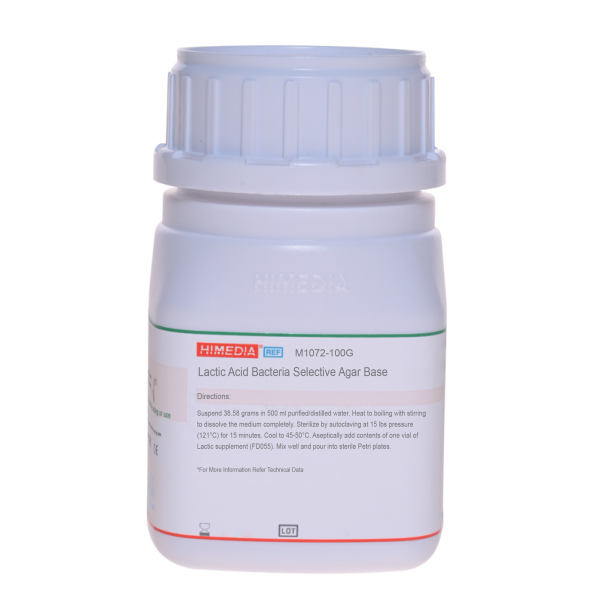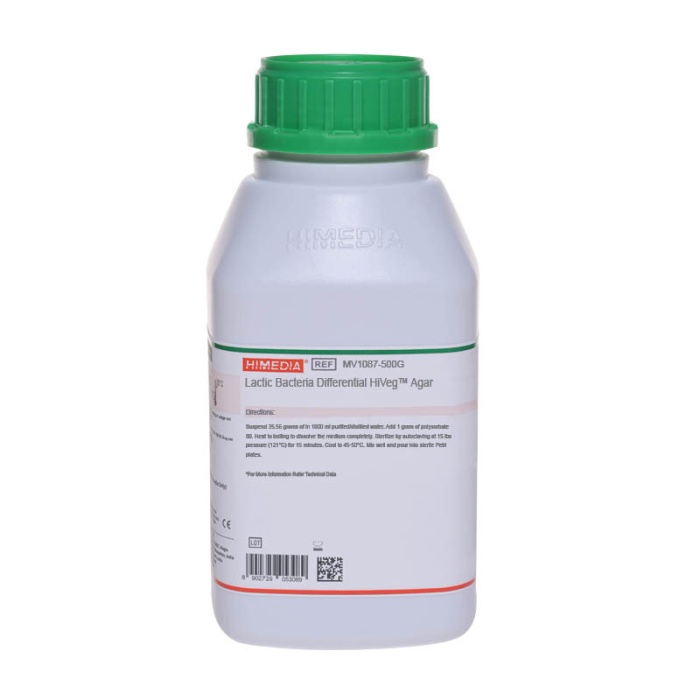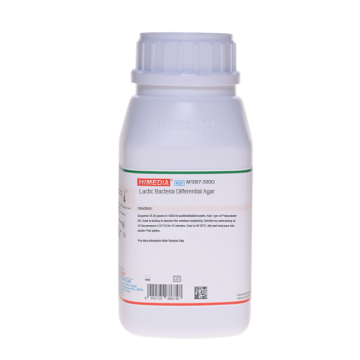 Your enquiry has been submitted
Your enquiry has been submitted
Lactic Acid Bacteria Selective Agar Base
Intended Use
Recommended for selective isolation of lactic acid bacteria.
Composition**
| Ingredients | Gms / Litre |
|---|---|
| Yeast extract | 5.000 |
| Tryptone | 20.000 |
| HL concentrate# | 1.000 |
| Maltose | 10.000 |
| Fructose | 5.000 |
| Dextrose (Glucose) | 5.000 |
| Betaine hydrochloride | 2.000 |
| Diammonium hydrogen citrate | 2.000 |
| Potassium aspartate | 2.500 |
| Potassium glutamate | 2.500 |
| Magnesium sulphate | 2.000 |
| Manganese sulphate | 0.660 |
| Potassium dihydrogen phosphate | 2.000 |
| N-acetyl glucosamine | 0.500 |
| Agar | 17.000 |
Final pH (at 25°C): 5.4±0.2
**Formula adjusted, standardized to suit performance parameters
# Equivalent to Liver concentrate
Directions
Suspend 38.58 grams in 500 ml purified / distilled water. Heat to boiling to dissolve the medium completely. Sterilize by autoclaving at 15 lbs pressure (121°C) for 15 minutes. Cool to 45-50°C and aseptically add contents of 1 vial of Lactic supplement (FD055). Mix well and pour into sterile Petri plates.
Principle And Interpretation
Lactic Acid Bacteria Selective Agar Base is based on the formula of Saha, Sondag and Middlekauff for the detection of lactic acid bacteria in beer and brewing processes (7). It is recommended by European Brewing convention (EBC) and the American Society of Brewing Chemists for isolation of Lactobacilli (2, 6). The family Lactobacillaceae has members that are important spoilage organisms in the brewing process.
The original medium viz. Raka-Ray Medium (7) was developed to enable brewers to monitor in-process beer quickly and accurately for a wide range of organisms including pediococci. Further studies towards optimization of conditions of growth factors led to the modification of Raka Ray medium with the addition of sorbitan mono-oleate to stimulate growth of lactic acid bacteria and incorporation of sugars such as fructose as an essential carbohydrate source for Lactobacillus fructivorans and maltose for lactobacilli as it lacks the ability to metabolize glucose.
Tryptone provides the nitrogenous compounds, potassium aspartate and potassium glutamate are additional sources of the respective amino acids while diammonium hydrogen citrate buffers the medium.
The addition of phenylethanol and cycloheximide in the supplement (FD055) make the medium selective for the isolation of lactic acid bacteria in beer. Phenylethanol inhibits gram-negative organisms, while yeasts are inhibited by cycloheximide. Polysorbate 80 or sorbitan monooleate (in FD055), HL concentrate, yeast extract and N-acetyl glucosamine act as growth stimulating agents. Fructose is the essential carbohydrate source for Lactobacillus fructivorans (8), maltose helps in detection of lactobacilli which cannot utilize glucose (5) whereas glucose is utilized by pediococci (1).
Type of specimen
Brewery samples
Specimen Collection and Handling
Inoculate around 0.1 ml beer sample onto Lactic Acid Bacteria Selective Agar Base plates. Spread the beer sample and overlay with 4 ml of M1072. Incubate at 25-30°C under anaerobic conditions. After use, contaminated materials must be sterilized by autoclaving before discarding.
Warning and Precautions :
Read the label before opening the container. Wear protective gloves/protective clothing/eye protection/face protection. Follow good microbiological lab practices while handling specimens and culture. Standard precautions as per established guidelines should be followed while handling specimens. Safety guidelines may be referred in individual safety data sheets.
Limitations :
- Further biochemical and serological tests must be carried out for complete identification.
Performance and Evaluation
Performance of the medium is expected when used as per the direction on the label within the expiry period when stored at recommended temperature.
Quality Control
Appearance: Cream to beige homogeneous free flowing powder
Gelling: Firm, comparable with 1.7% Agar gel.
Colour and Clarity of prepared medium: Dark amber coloured clear to slightly opalescent gel forms in Petri plates.
Reaction: Reaction of 7.7% w/v aqueous solution at 25°C. pH: 5.4±0.2
pH: 5.20-5.60
Cultural Response:
Cultural characteristics observed under anaerobi condition, with added Lactic Supplement (FD055), after an incubation at 25-30°C for 18-48 hours.
| Organism | Inoculum (CFU) | Growth | Recovery |
|---|---|---|---|
| Lactobacillus acidophilus ATCC 11506 | 50-100 | good-luxuriant | >=50% |
| Lactobacillus plantarum ATCC 8014 | 50-100 | good-luxuriant | >=50% |
| Lactobacillus fermentans ATCC 9338 | 50-100 | good-luxuriant | >=50% |
| Lactobacillus brevis ATCC 367 | 50-100 | good-luxuriant | >=50% |
| Lactobacillus buchneri ATCC 11307 | 50-100 | good-luxuriant | >=50% |
| Pedicoccus acidilactis ATCC 8042 | 50-100 | none-poor | <=10% |
| Escherichia coli ATCC 25922 (00013*) | >=104 | inhibited | 0% |
| Saccharomyces cerevisiae ATCC 9763 (00058*) | >=104 | inhibited | 0% |
Key: (*) Corresponding WDCM numbers.
Storage and Shelf Life
Store dehydrated and the prepared medium at 2-8°C. Use before expiry date on the label. On opening, product should be properly stored dry, after tightly capping the bottle in order to prevent lump formation due to the hygroscopic nature of the product. Improper storage of the product may lead to lump formation. Store in dry ventilated area protected from extremes of temperature and sources of ignition Seal the container tightly after use. Product performance is best if used within stated expiry period.
Disposal
User must ensure safe disposal by autoclaving and/or incineration of used or unusable preparations of this product. Follow established laboratory procedures in disposing of infectious materials and material that comes into contact with sample must be decontaminated and disposed of in accordance with current laboratory techniques (3,4).
Reference
- Coster E. and White H.R. (1951) J. Gen. Microbiol. 37.15.
- European Brewing Convention, EBC Analytical Microbiologica: Part II J. Inst. Brewing (1981) 87. 303-321.
- Isenberg, H.D. Clinical Microbiology Procedures Handbook 2nd Edition.
- Jorgensen, J.H., Pfaller, M.A., Carroll, K.C., Funke, G., Landry, M.L., Richter, S.S and Warnock., D.W. (2015) Manual of Clinical Microbiology, 11th Edition. Vol. 1.
- Lawrence D.R. and Leedham P.A. (1979) J. Inst. Brewing 85. 119.
- Methods of Analysis of the ASBC (1976) 7th Edition. The Society, St. Paul Mn USA.
- Saha R.B., Sondag R.J. and Middlekauff J.E. (1974) Proceedings of the American Society of Brewing Chemists, 9th Congress, 1974.
- Van Keer B., Van Melkebeke L., Vertriest W., Hoozee G. and Van Schoonenberghe E. (1983) J. Inst. Brewing 89. 361-363.
| Product Name | Lactic Acid Bacteria Selective Agar Base |
|---|---|
| SKU | M1072 |
| Product Type | Regular |
| Physical Form | Powder |
| Origin | Animal |
| Packaging type | HDPE |
| References | 1. Saha R.B., Sondag R.J. and Middlekauff J.E. (1974) Proceedings of the American Society of Brewing Chemists, 9thCongress, 1974. |
| Customized Product Available | No |










